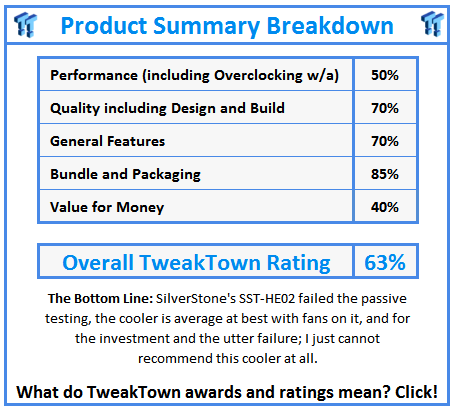Introduction
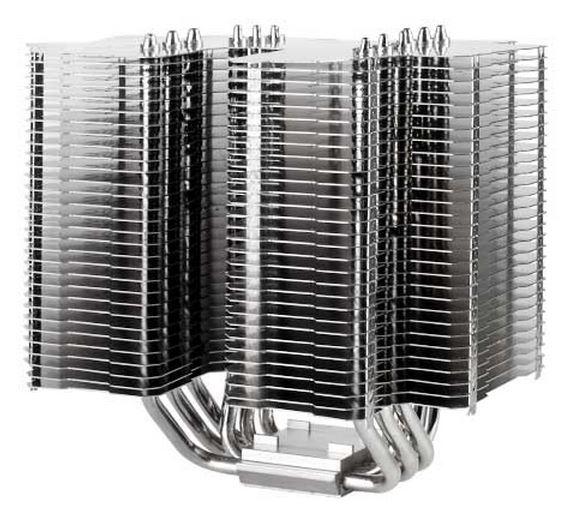
What I think I like most about my job is that I get to test all the latest ideas that come down the pipe to retail aftermarket tech components. With CPU coolers more specifically, I have seen all sorts of configurations, all sorts of tower concepts, low profile, round ones, square ones; well you get the idea. What you don't see publicized very often at all are passive cooling solutions. I can think of only one or two other coolers I would run passively in all my time reviewing CPU coolers, but nothing designed with that intention out of the gate.
As we already know the guys and gals over at SilverStone are always trying its hands at innovation with designs that you may not have considered. Even if the design is similar to something else you may have seen, a ton of R&D goes into even the finest details with them. Keeping with this trend, basically SilverStone took the HE01 we saw not too long ago, added a ton more surface area, and ship this new cooler without fans with the intention to be able to control the heat of the latest and greatest processors, within certain limits.
I am speaking of the monstrously big SST-HE02 from the Heligon series of coolers. Without giving it all away before we jump into the specs, let me just say this cooler is wide, deep, not so tall, but weighs in at 990 grams of nothing but copper and aluminum. The design of this cooler is only passive for 95W processors without some sort of air flow. With optional fans or a bit of case air flow the figure is raised to a 150W TDP and beyond depending on the fans chosen to cool this massive tower.
I know for a fact that this review will interest you to see the results. I plan to passively test, test with a case fan setup, and even with strapping on a pair of average spec'd fans to give the HE02 all the chance in the world to keep my processor cool. Let's see just how well it does that.
Specifications, Availability and Pricing
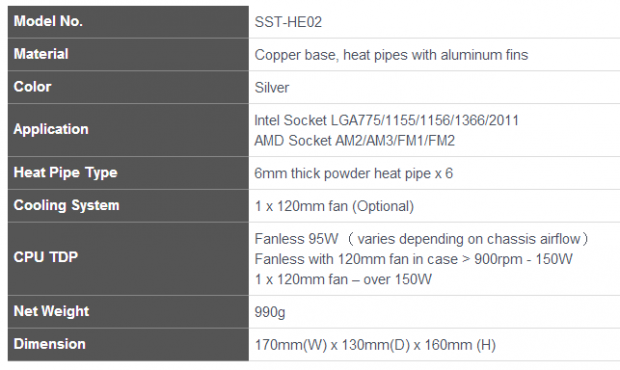
Looking at this cooler you first notice the irregular, almost hash tag shape of each of the fins on the HE02. There are 30 0.5mm thick aluminum fins to be exact. These fins take the heat from six, 6mm diameter, heat pipes, which get their heat from the two piece copper base that they are soldered into. To fight corrosion and help users wipe off finger prints, the entire cooler is coated in nickel plating. Dimensionally the HE02 is 170mm wide, 130mm deep, and stands 160mm tall. While it may eat up most of the motherboard, the lowered height makes this a contender for most mid-tower cases. The last thing to consider is the immense weight of the HE01 that comes in at 990 grams without any fans attached to it.
I want to cover the CPU TDP section very well, because this is very important information to wrap your head around. SilverStone gives the HE02 a 95W TDP rating for completely passive use. This means with no fans around the cooler, it should be able to control the heat from anything 95W or less. They then say that with the addition of case fans, without anything on the cooler body, the TDP then raises up to 150W. This means that you can even OC most of today's top tier processors just with the airflow of the case in play. If you want to go all out with the HE02, SilverStone advises fans attached directly to the cooler to take the TDP beyond the 150W mark, but there isn't a maximum rating since they have no idea what fans you may choose to use. Obviously something like 151CFM Delta fans are going to raise the TDP much more than say an average 50CFM case fans equivalent.
Diving into Google Shopping to shop for the SST-HE02, I found the cooler is priced quite reasonably as long as the cooler performs up to expectations of the limits of the set TDP structure. Currently I was only able to find four locations offering the HE02, and cheapest of which was Newegg with a $65.99 price tag. That is a deal that not only comes with free shipping, but if you are a rebate hound, you can also get another $5 off that price currently. Since most of the other listings are much closer to $70 plus shipping, I see no reason to shop anywhere else if the HE02 ends up being a cooler you want to put in your build.
As with anything I would suggest you buying, we must look at all the fine details and put it through its paces. Stick with me through the packaging and cooler images as the testing reveals something that is well worth continuing along.
Packaging
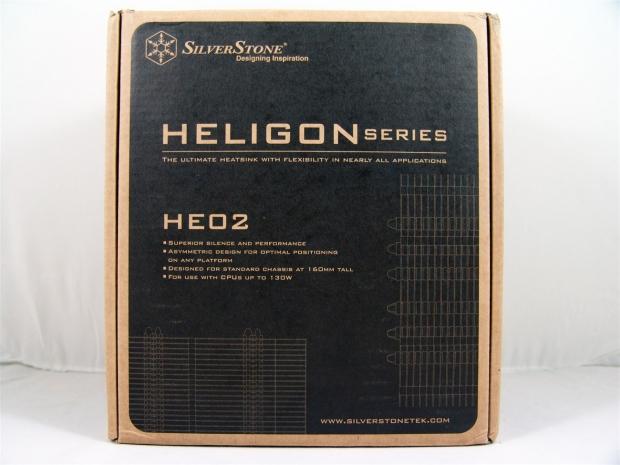
The packaging for the Heligon HE02 CPU cooler keeps it basic with the use of plain brown cardboard with black printing to deliver the information. On the top, you see the series name, the cooler name and four features that will pique your interest.
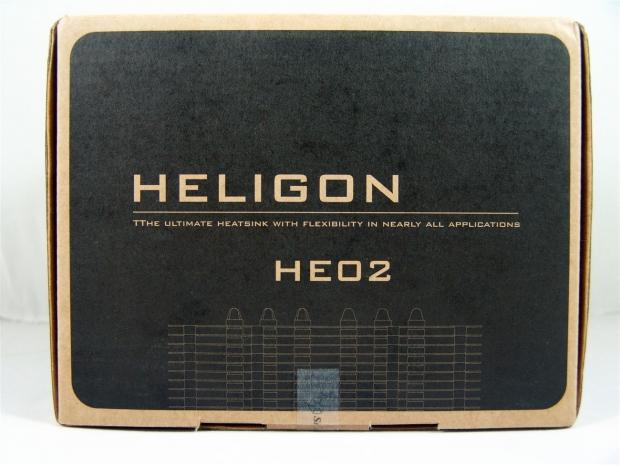
Lying the box down to cover the sides of the packaging, we will start with what was the bottom in the last image. Here you get a bit of a cooler at the bottom and the series and cooler name.
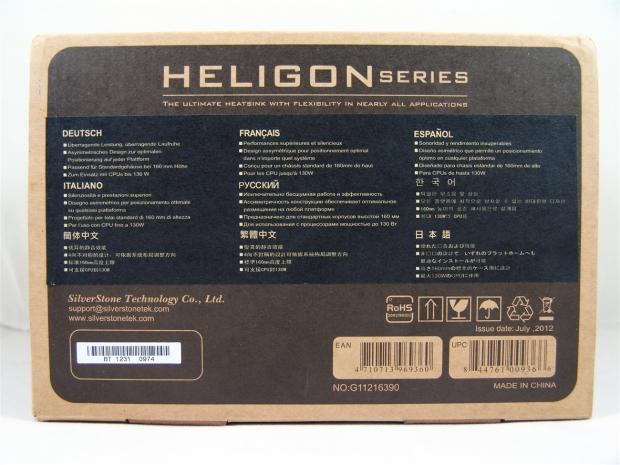
The next panel covers those same four features listed on the top, but this time in nine various languages.
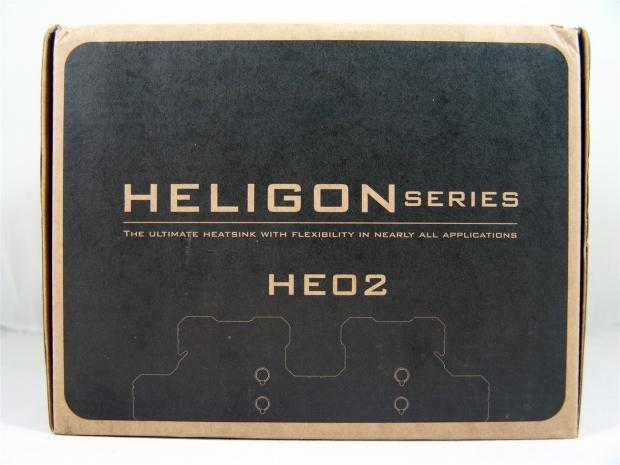
The line "the ultimate heatsink with flexibility in nearly all applications" has been on a few panels and besides the rendering of half of a top fin, there isn't much new to discuss.
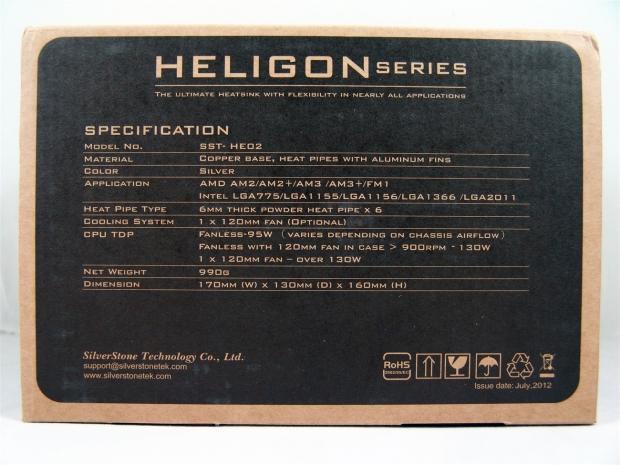
The last panel that makes up the sides of the packaging delivers the full list of specifications of the SST-He02 inside of this box.
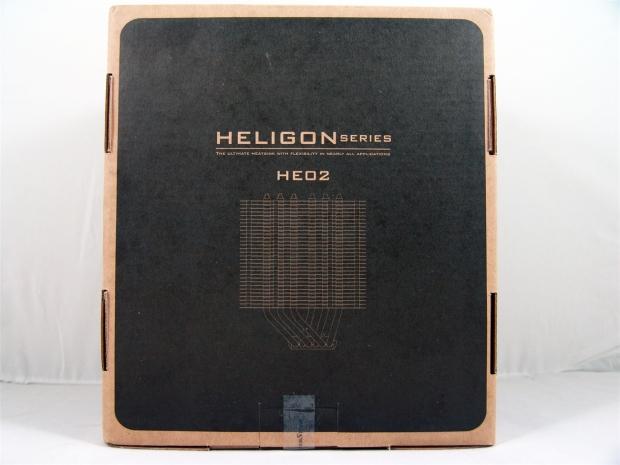
Even the bottom, or the back, depending on how you look at it is treated with the Heligon series, the HE02 naming, and a look at the HE02 from one of the sides.
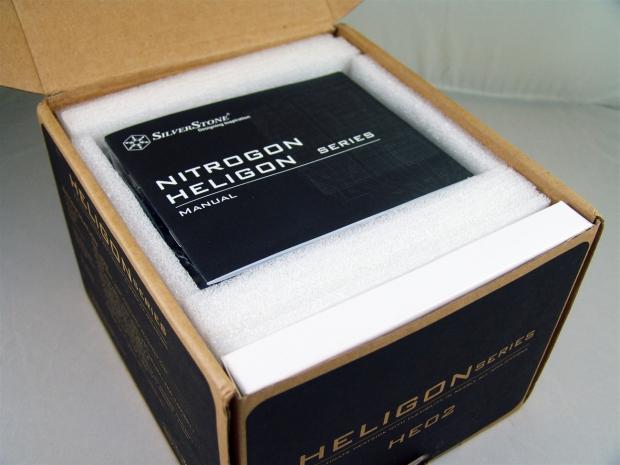
When you first open the box you can tell right away with all the high density foam and the way the paperwork is sitting nicely in place that this cooler had a gentle ride to my house inside of this box.
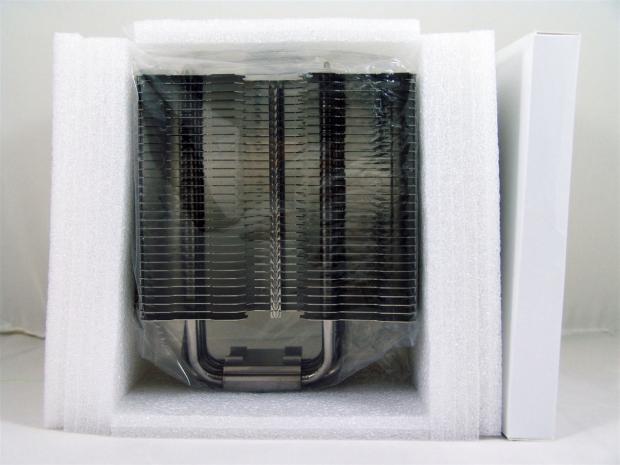
The cooler body is shipped inside of a plastic bag to help keep oxidation down while it is stored on the shelf. It is then completely surrounded with high density foam to make sure it arrives in one piece. Down one side of the cooler you will also find a white cardboard box that includes all of the mounting hardware.
SilverStone Heligon SST-HE02 Passive CPU cooler
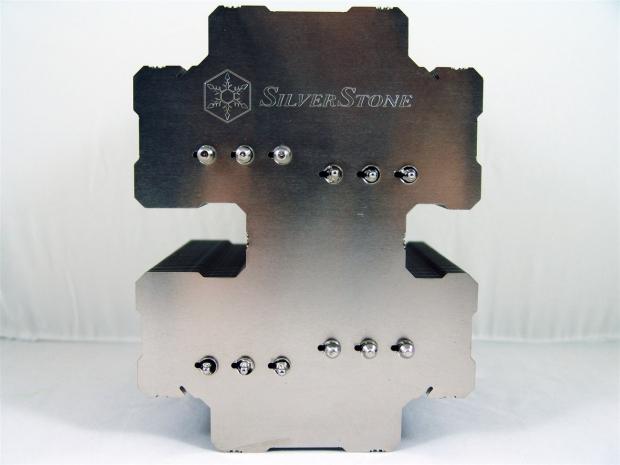
I thought it would be best to show the top of the HE02 first so that you could grasp what you are about to see on the sides. As for the top of the cooler there is the SilverStone logo and name on it as well as the six offset heat pipes protruding through the fins as they are pressed over them.
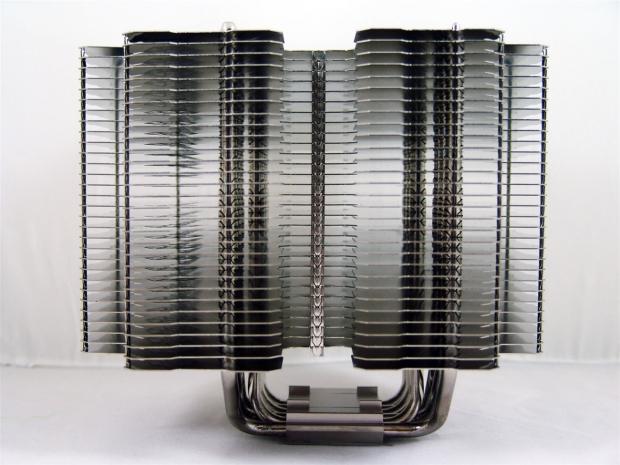
With the larger half of the cooler now on the left side, you can see through the cooler and the edges of the 0.5mm thick aluminum fins. You will also see as the middle is supported on this side, there are a total of ten supports on each fin to keep the spacing correct.

On this side you can see that there are four support rails, two near the middle, and one on each side as the fins step back. You can also see the heat pipe spacing and how well it will deliver heat right into the bulk of the 30 fins.
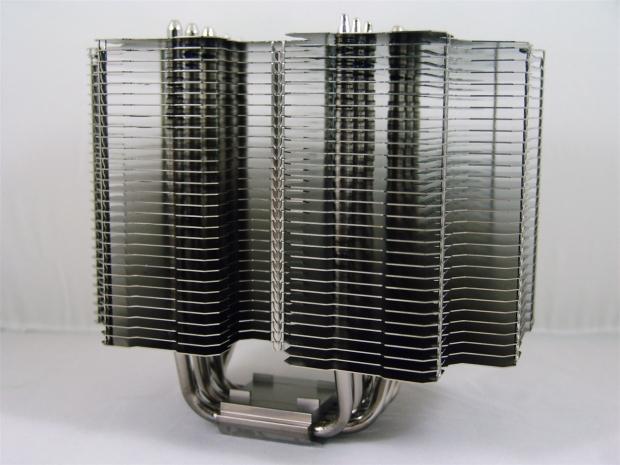
I changed up the angle a bit so that you can see how the sides bump out twice. The front edge, the center section where the supports are and the trailing edges are all set back from the two wider sections.
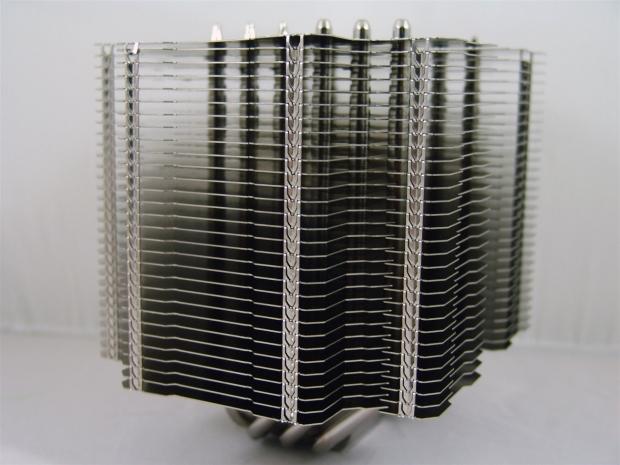
I did the same with this side shot of the HE02. This way you can get an idea of the grooves to mount optional fans that are provided and to again show the stepping of the design.
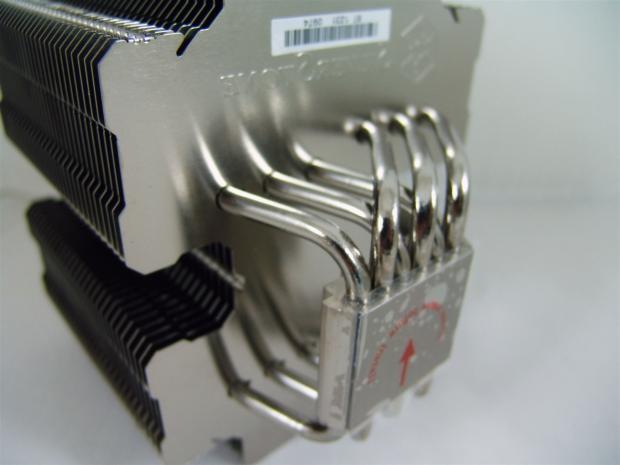
Under the cooler, as the 6mm diameter pipes leave the base, every other pipe goes the opposite direction allowing for a complete dispersal of the heat load of the CPU. In simpler terms, it spreads the heat evenly with the center most pipes not having to run down the middle of the cooler.
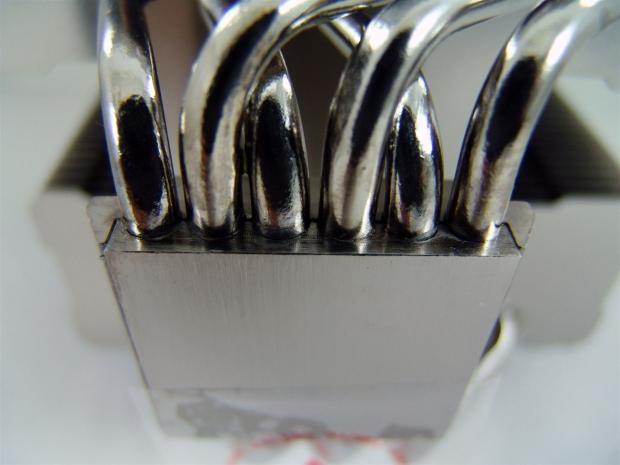
Moving in much closer to the side of the base, I almost thought these pipes were soldered in, but as you will soon see, there is TIM spilling out the sides, so I can only assume that is what is making the contact here as well.

The base is flat when a razor is set against it, but the finish is left a bit rough before the plating is applied. Also as you can see on the edge of the base, that is grey TIM oozing out between the two halves.
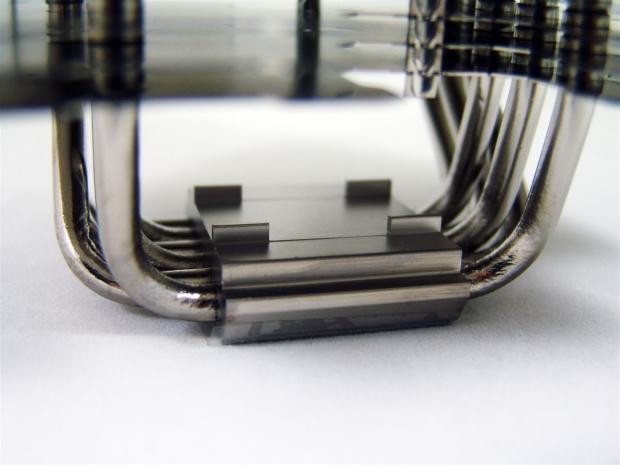
On the flip side of the base section there are four tabs milled into the top portion. This allows for the cooler to use a center cross bar to mount the cooler like with the HE01. This is also why the sides are notched in the middle, to allow you to screw the cooler down to the rest of the hardware.
Accessories and Documentation
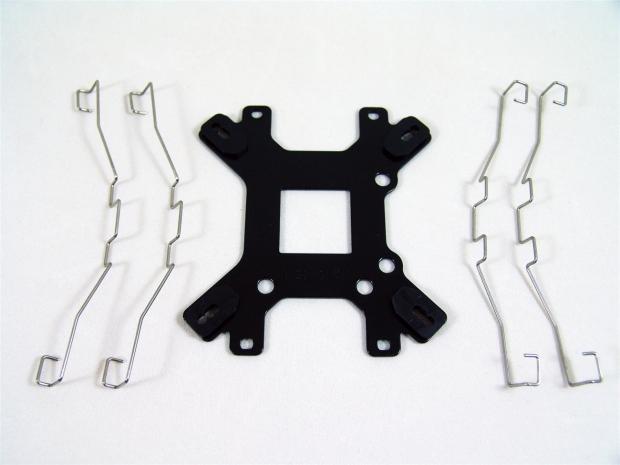
Along with a back plate that is universal for AMD and Intel CPUs, it comes with thick plastic pads around the Intel mounting to isolate it from the motherboard. Also included in the hardware is a set of four wire fan clips so that you can easy strap on a pair of fans if you want to.
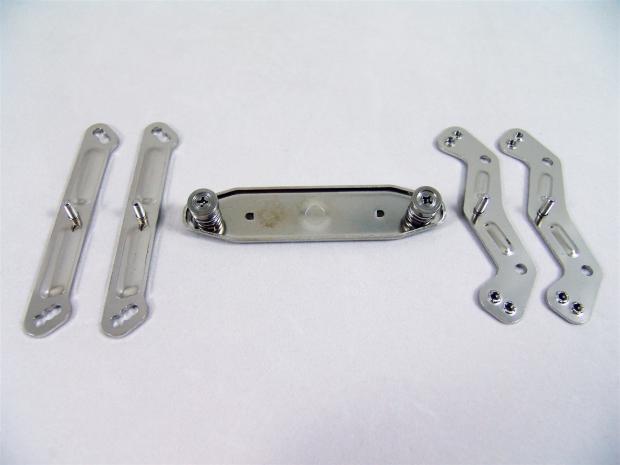
The top half of the mounting system is what you are now looking at. To the left is a pair of brackets for Intel mounting. On the right is the pair for AMD. This leaves the long center cross-bar to mount the cooler to the screws on the other mounting components.
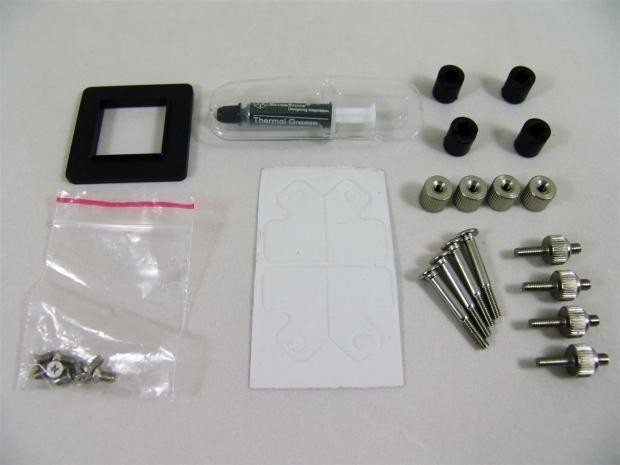
The rest of the kit includes an LGA775 support, thermal grease, four plastic spacers, the screws that have no use with this cooler, AMD isolation pads for the back plate, thumbscrews, bolts for all other sockets that LGA2011, which is what the thumbscrews at the bottom right are for.
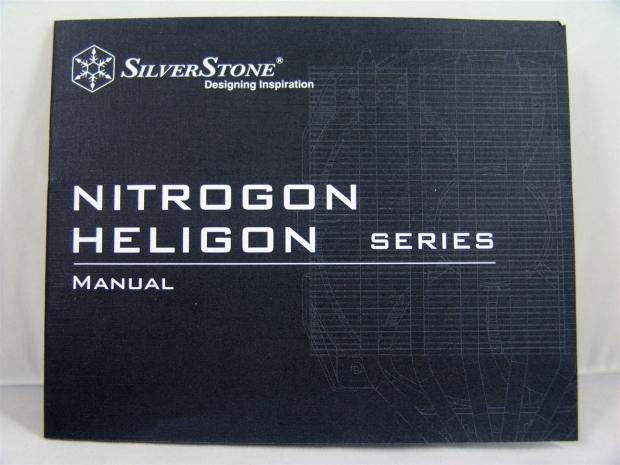
The manual that comes atop the cooler in the box is what you are looking at. The manuals cover offers very little information outside of the series, cooler name, and the rendering of the HE01 on the front.
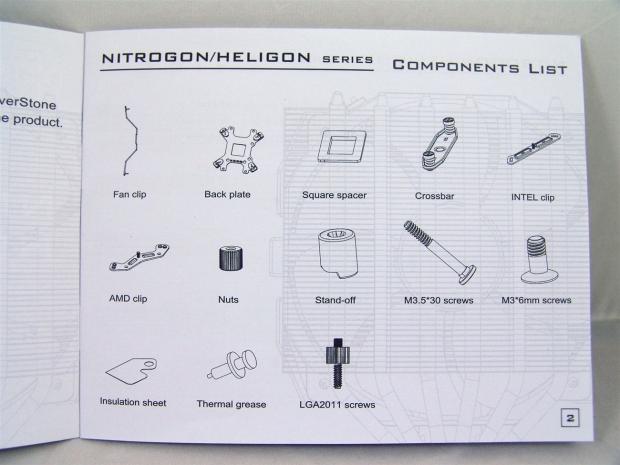
The manual starts out with a full list of components that should have been included with the HE02 cooler. Now is a good time to look through the packaging to see that you have all of these parts. On the next page it will also show the quantities of each piece listed here.
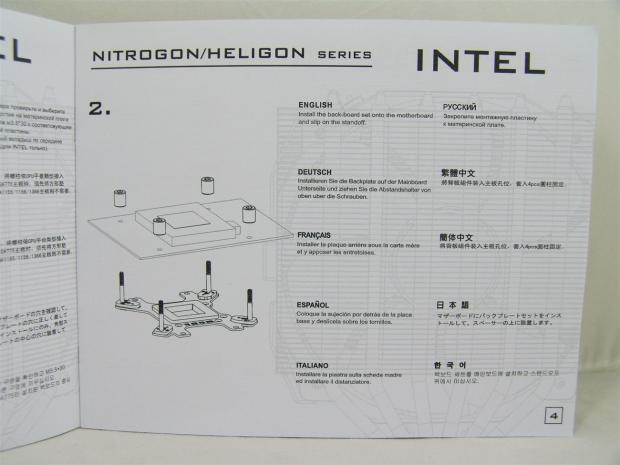
As for what to expect from the instructions, you are given very good renderings to figure out what they are trying to accomplish in each step. Since they do cover all ten languages on each step, the descriptions are precise and to the point with not much extra help. One good thing is that this hardware is very self-explanatory if you have ever installed an aftermarket cooler with good mounting.
Installation and Finished Product
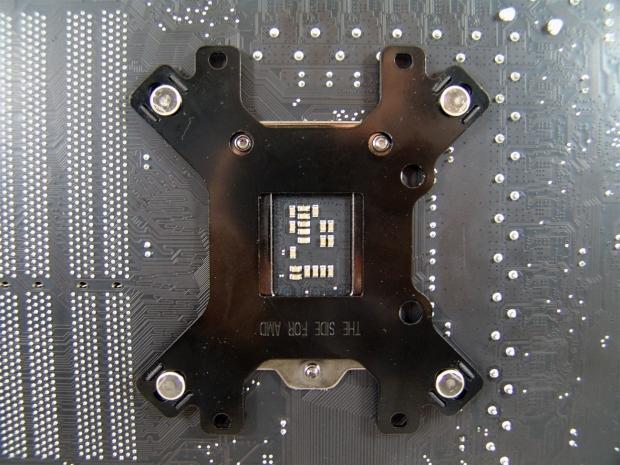
Sliding the long threaded bolts through the back plate and setting it against the motherboard allows you to set on the plastic spacers on the other side to help hold these bolts into place while finishing up the rest of the hardware mounting.
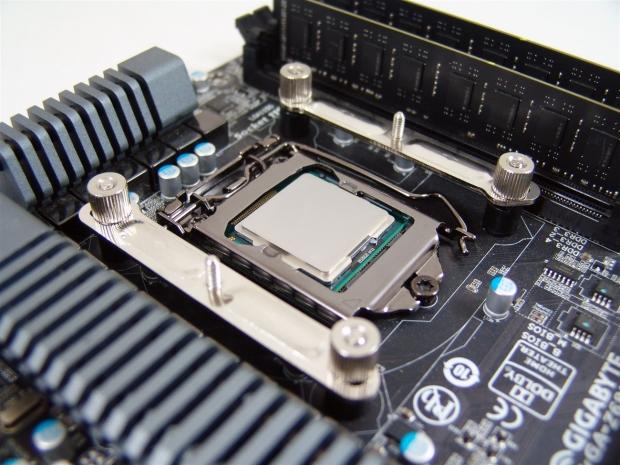
With the black plastic spacers gripping the bolts, you just set on the appropriate top rails and use the nuts to secure the top plates to the back plate making the hardware locked in place so that the cooler is ready to mount.
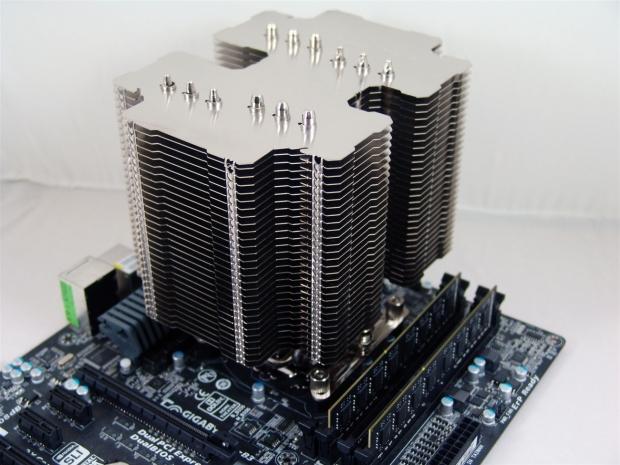
With the cooler now mounted to the motherboard you realize two things. First you realize how big this HE02 is, and secondly, you can now understand why the sides are notched allowing you access to the cross-bar screws.
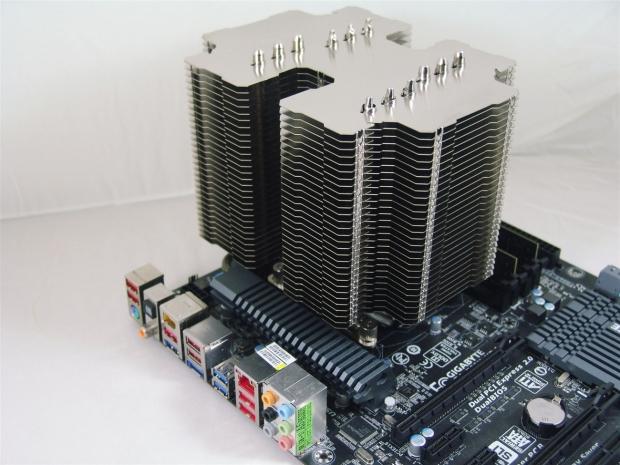
Looking at the HE02 from the left shows that it doesn't quite extend over the VRM heat sinks on the motherboard, nor does it block access to the 8-pin EPS connector. It also doesn't drop down and encroach on my video card slot either.
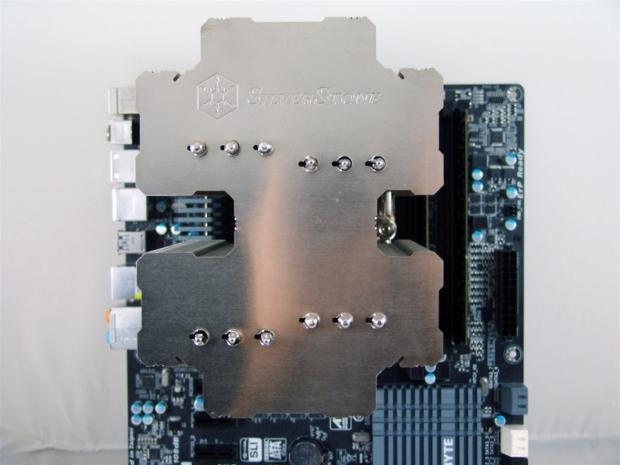
When you view the HE02 from the top the brushed finish of the fins shows through along with the SilverStone name at the top. You can also tell much better now how those wire fan clips will work when adding your own fans.
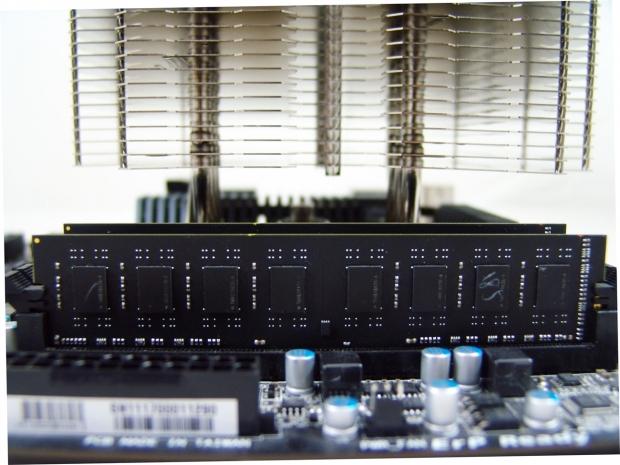
Without any fans, the HE02 is well out of the way, and even has room for a couple extra fins down here in my opinion.
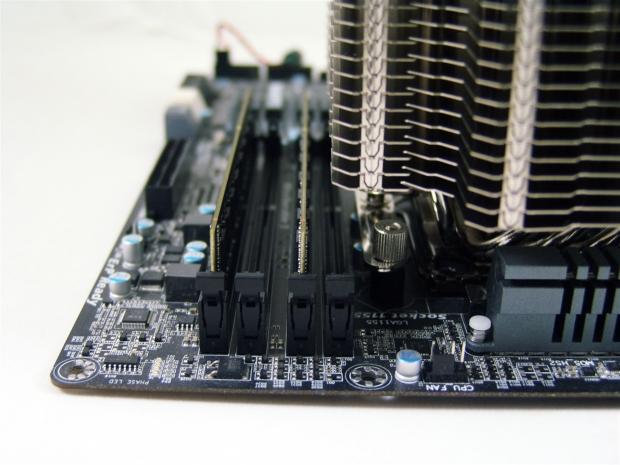
Even without a fan on the cooler it does end up blocking off the use of the fourth RAM slot only if I had taller heat spreaders. With the naked sticks I use, I could get the stick in and out with little issue.
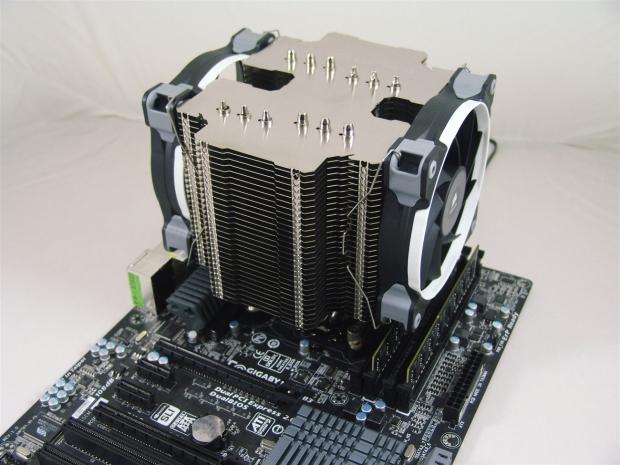
Just because I am going to be testing like this anyways, I figured I would also show you what the HE02 looks like with a pair of fans installed.
The Test System and Thermal Results
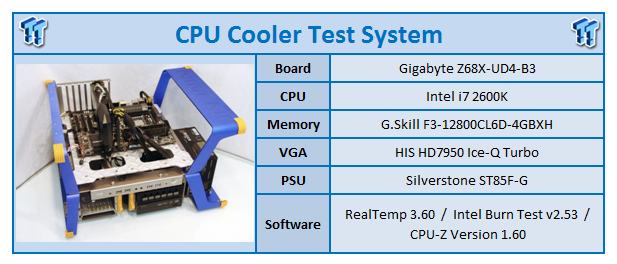
I would first like to thank HIS, GIGABYTE , InWin and AVADirect for supplying products for me to test with.
Testing for the CPU coolers is done with the use of RealTemp to ascertain temperatures, Intel Burn Test to deliver the load to the CPU and CPU-Z to verify the CPU speed and the voltage being used in Windows. All of the testing is done with an ambient temperature of 24.5-25°C and humidity is maintained to 35% sometimes less.
For the "stock" runs, it's more of a plug and play setup where the PWM of the motherboard is in control of the fans speeds for both the idle and load results. Speed Step is active and the processor idles at 1600 MHz and loads at 3500MHz for the stock settings. I also set the memory to run at 1600MHz for stock. As for the overclocked runs, I load the CPU at 4.5GHz and idle results are obtained with 7.5V to the fans while the load run is set to deliver 12V to the fans. This allows me to gauge the lowest and highest fan ratings for my charts.
You are going to be seeing four results for the cooler test results. First is Passive Testing, denoted in the chart as *Passive. This is exactly what it states, no fans were added, just the natural convection of the cooler and the room it is in were at play. Then you will have a run with a fan I strapped onto the X-frame at seven inches in front of the cooler, denoted as *Case Fan. This is where air is just blowing at the cooler, with no real intention but to create better ambient flow to aid the convection of the cooler. Then of course you will have runs with two 120mm fans attached to it denoted as *Dual Fans. The last one you will see if where I actually overclocked it with the fans on it to see what would happen.
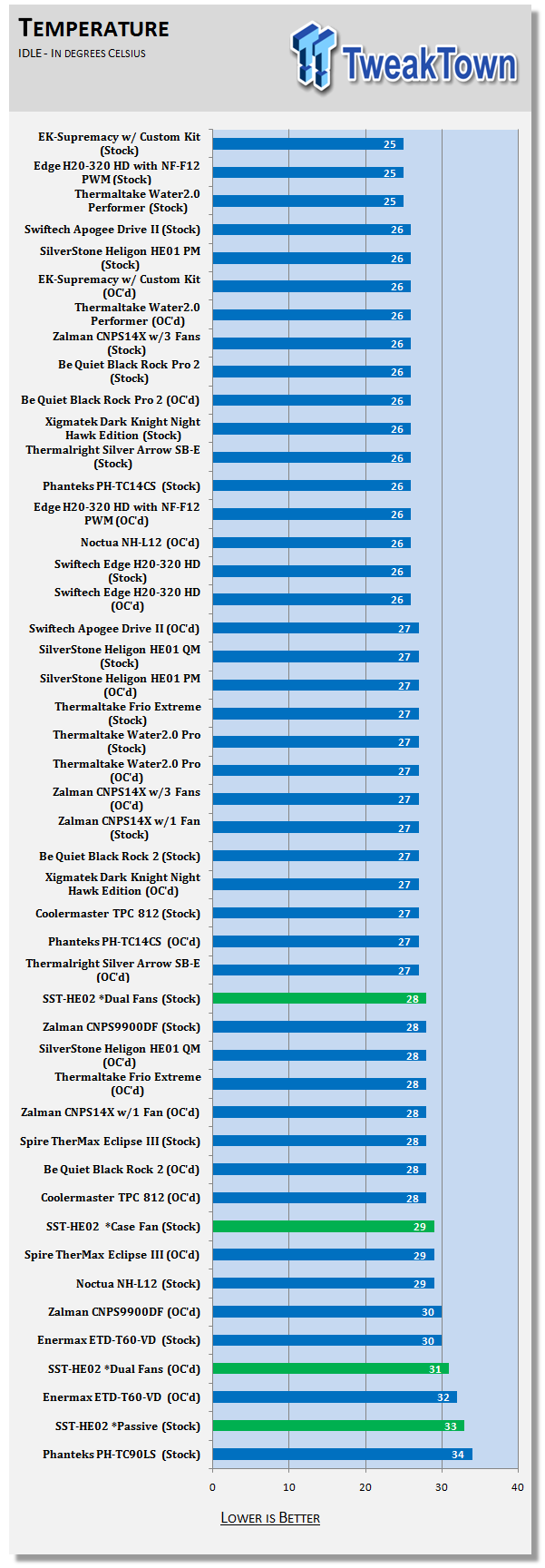
In the idle testing the HE02 performed much like I would have expected. The worst result was when it was run passive reading 33°C. As you add fans the numbers get better. To the point of which a 28°C reading was obtained with the pair of 120mm fans strapped right to the HE02.
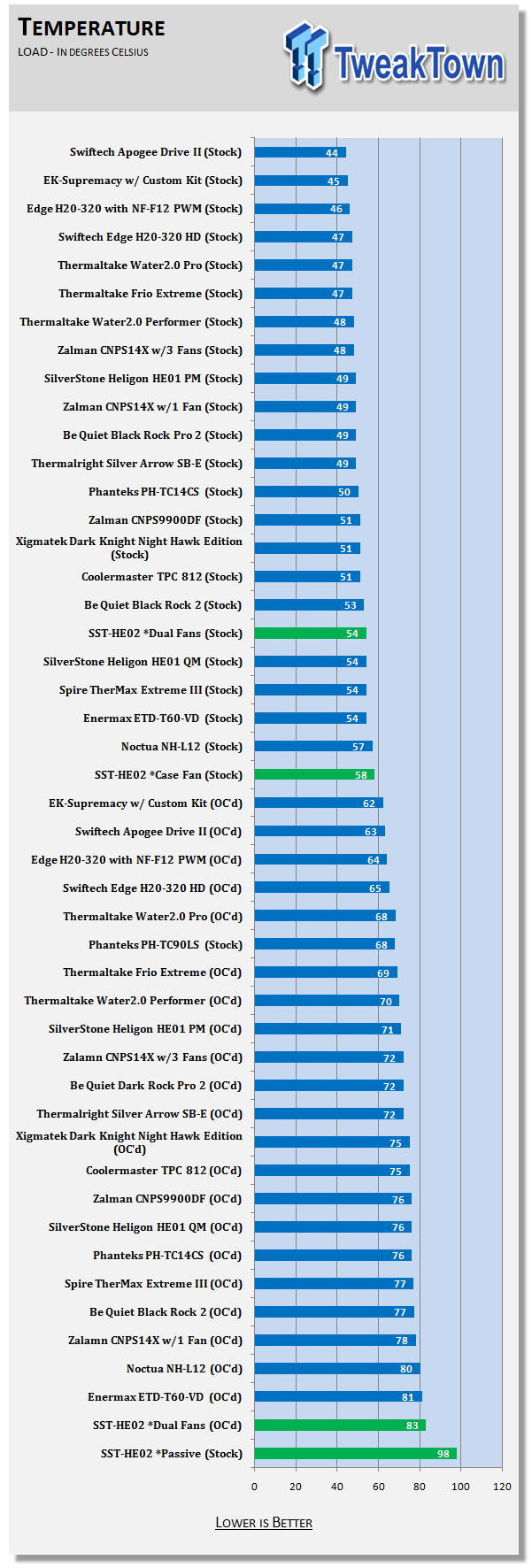
Loading the 2600K with fans on the HE02 or with a fan blowing at the cooler resulted with a mediocre result of 54C and 58C. For such a large cooler I would have expected better. Where I really had to deliver the pain was in the overclocked results with the pair of fans on it, I was only able to keep the processor at 83C.
Where it got scary was in the passive testing, and my 2600K fits in the 95W specifications. Here we hit 98C with the CPU throttling and LOG being shown in RealTemp. Not so impressive, not good at all.
Final Thoughts
You may have noticed that I didn't do any sound charts, and this is because that is very subjective to the fans chosen to run with the cooler. Since SilverStone doesn't include any fans with the HE02 I thought it was not needed to show you the noise levels of my specific fan choices. That being said I am really at a loss for words to fill this conclusion. I don't want to sound like this cooler is a complete waste of time, but any way you look at it; this is not a passive cooling solution. The 2600K falls well within the specifications and passively the HE02 failed to handle it at all, even allowing the chip to throttle as the temperature was trying to go higher. Even if you look at the results with the fans strapped to it, the results are mediocre at best.
I mean essentially there is no real difference in the results between pointing a fan in the HE02s general direction as if a case fan were cooling this massive tower or I had the fans right on the cooler body. With the amount of open side to this cooler, unless they boxed it in to force air through it instead of blowing by the fans out he sides of the cooler, I don't see this cooler getting great results until you break out the Ear Splitter series of fans. With so much mass hanging off the CPU socket, and how poorly this sample cooled, I am disappointed to say the very least. I would have guessed, maybe even place a wager that this should have done better, but the repeated testing and multiple cooler applications I tried, the results being consistent over all of that speaks for itself.
Even if you were the type who still thinks I did something drastically wrong, and was investing just to prove me wrong, consider this. The cooler is going to set you back $65.99, even more if you don't buy from Newegg. Then on top of that, I know I gave mine up a few years ago, so I would also have to invest in a pair of Delta fans or some other 38mm thick fan that brings the ear pain when running at full speed.
Then and only then, do I think this cooler might pull into a respectable cooler, but the investment when you are all done is now much closer to $100, and there is no way I can get behind a cooler at that price just to get better than average results from a cooler that is said to be passive and fails to even do that right. Give this one a miss.


